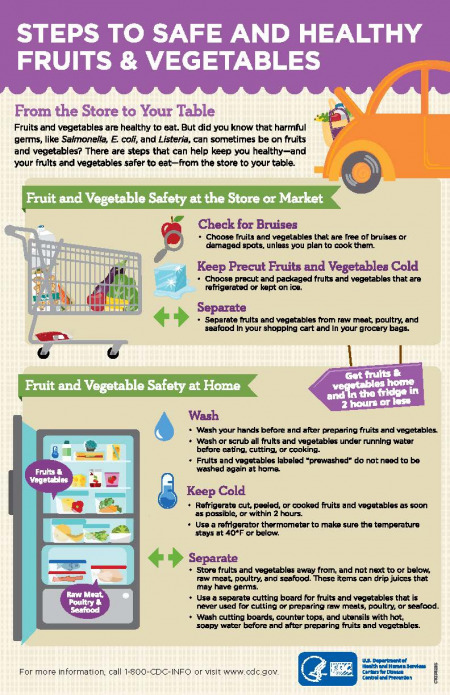If you’ve moseyed through the produce aisle of your local grocery store lately, you may have noticed that things are a bit more colorful. The strawberries and blueberries that once lay limp on the shelves have sprung to life in vibrant red and blue; the raspberries that looked dull and wilted throughout winter have ripened to sparkling shades of purple.
No, you’re not just viewing the world through rose-colored glasses. Summer is the time when most berries are in season, meaning they’re at their peak freshness and flavor. But before you start snacking from your bushel full of fresh strawberries, you should know: just like other raw food sources, fruits and vegetables can contain harmful bacteria like E. coli, Listeria, or Salmonella that can lead to foodborne illness — a.k.a. the dreaded food poisoning.
According to the Food And Drug Administration (FDA), there are many ways your fresh produce can become contaminated from soil to store. During the growing process, fruits and vegetables can come into contact with animals, harmful substances like pesticides in the soil or water, or unhygienic hands of the workers who touch them.
After harvest, the produce is passed through many more hands that increase the risk of contamination. Even after the produce has been purchased from the store, contamination can occur during food preparation or improper storage.
The thought of contaminated fruit may make you cringe, but don’t worry — you can avoid getting sick with a few simple steps. The next time you’re seduced by a crate of bright summer strawberries, follow these FDA-approved tips to stay safe from store to table.
At The Store
1. Choose Undamaged Produce
Make sure your fruits and vegetables are free of bruising or other signs of damage before plopping them in your cart. When buying berries, turn over the container to check for signs of mold at the bottom of the package, as this is where moisture usually collects.
2. Keep Pre-Cut Produce Cold
When buying pre-cut items such as prepared salads or watermelon slices, make sure they’re either refrigerated or on ice. The cold temperature will keep bacterial growth at bay.
3. Separate Your Produce
While shopping, separate your fruits and vegetables from meat, poultry, and seafood in your cart and grocery bags. This will help prevent cross-contamination.
At Home
4. Wash Your Hands And Surfaces
Before and after handling fresh produce, thoroughly wash your hands with warm soap and water for at least 20 seconds. Also, wash or scrub your kitchen utensils and surfaces, including knives, cutting boards, and countertops.
5. Cut Away Damaged Areas
If you notice bruising, mold, or other damage to your purchased produce, cut away the damaged parts before preparing, eating, or returning to storage. This is especially important with moldy fruits and vegetables, as mold spreads quickly from one area to the others.
6. Wash Or Scrub Your Produce
Unless your produce is labeled “prewashed,” all fruits and vegetables must be washed thoroughly before eating. Even produce with a peel should be washed or scrubbed to prevent bacteria from the peel spreading to the inside of the fruit or vegetable while cutting.
To wash berries, gently rub your produce while holding it under plain running water; the FDA does not recommend cleaning with soaps, detergents, or commercial products. To wash firmer produce like cucumbers and melons, you may scrub with a clean vegetable brush.
7. Bonus: Boost The Shelf Life
While plain running water is sufficient to banish harmful bacteria from your summer berries, adding a little vinegar to your wash routine can help extend the shelf life (the acidic solution effectively inhibits further microorganism growth).
To make a vinegar soak for your produce, combine 3 parts water and 1 part distilled white vinegar in a bowl; then dip your pre-rinsed produce in the mixture. Just dunk; don’t soak for too long, unless you want your sweet strawberries to absorb the vinegar flavor. Then drain your produce with a colander, and rinse with plain water again.
8. Dry Your Produce
After washing (or dunking), gently pat your produce dry with a clean cloth or paper towel to dry. This step can further reduce bacteria that may be present.
9. Store Your Produce Properly
Refrigerate your leftover produce (at or below 40°F) within 2 hours of cutting, peeling, or cooking. In the refrigerator or freezer, separate fruits and vegetables from meat, poultry, and seafood to prevent cross-contamination.
10. Repeat The Cleansing Process
Enjoy your fresh summer berries again and again!

What are your tips for keeping summer berries fresher for longer? Share your secrets in the comments!
Looking For More Summer Treats? Check These Out:



